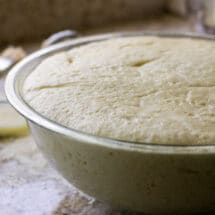
How to Proof Dough
Proofing is the step in bread making when yeast dough rests and rises before baking. Professional kitchens use a proof box, but you can create a similar warm environment using just your oven.
Servings 32 rolls
Calories 82kcal
Ingredients
- 2 pounds dough
Instructions
- For a first rise, Add the dough to a greased bowl, brush with melted butter or oil, and cover with plastic wrap. For a second rise, roll out and shape the dough according to your recipe.
- Turn your oven on to the lowest temperature it will go, usually 200 degrees. Once it reaches 110 degrees, turn the oven off. Place the dough in the oven and close the door. Opening the oven door will lower the heat a bit, and that's okay (you're aiming for 75 to 85 degrees).
- Keep the oven door closed for the duration of the proofing time according to your recipe. For example: 1-1/2 to 2 hours or until the dough has doubled in size for the first rise and 30 minutes for the second rise. Some recipes require two or even three proofs before baking. You can repeat the steps as necessary every time, if needed.
Notes
- Bulk fermentation versus proofing: Technically, bulk fermentation is letting the entire batch of dough rise before it is shaped. Proofing is the technical term for the final rise, after shaping but before baking.
- Temperature: Ideal temperature range for yeast to work is between 75 degrees and 85 degrees Fahrenheit. Yeast cells will die at 138 degrees Fahrenheit.
- Follow your recipe: Because baking is a science, please follow the instructions of the specific recipe you're making.
- Time: This will be different can vary depending on the recipe, and can range from 1 to 3 hours. A warmer environment, a warmer dough, and more yeast can make for a faster rise.
- Spring back: Bread bakers know proofing is done when the dough has doubled in size, and no longer springs back when pressed with two fingers.
- No-time dough: Recipes made with more yeast to speed the fermentation process.
- Retardation: Fermenting dough under refrigeration to slow the yeast activity. This allows the dough to develop more flavor and can help with timing for production baking.
- Testing yeast for freshness: Dissolve 1/2 teaspoon sugar in 1/2 cup warm water. Add one packet (or 2 teaspoons) yeast, stir, and wait 10 minutes. If the yeast mixture is bubbly and domed, your yeast is active and ready to go. (You can use the same yeast you tested--just reduce the liquid in your recipe by 1/2 cup.)
Nutrition
Calories: 82kcal | Carbohydrates: 16g | Protein: 3g | Fat: 1g | Saturated Fat: 1g | Sodium: 145mg | Potassium: 36mg | Fiber: 1g | Sugar: 1g | Vitamin C: 1mg | Calcium: 12mg | Iron: 1mg